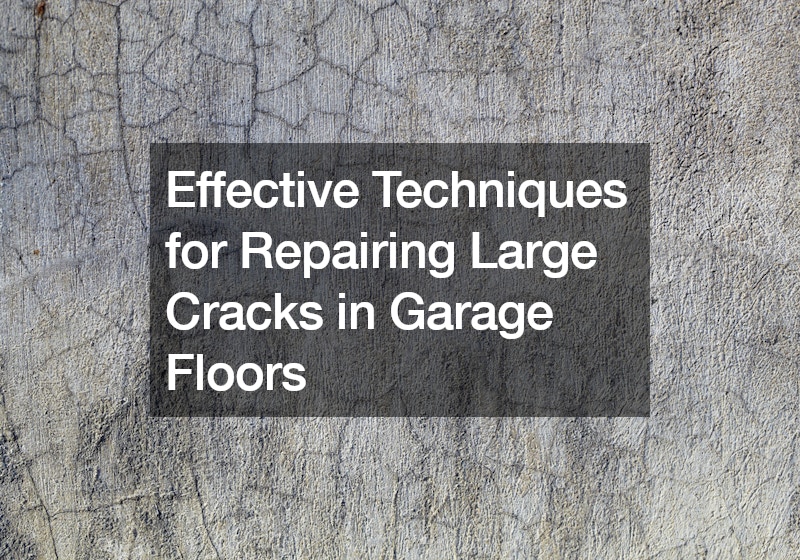Garage floors endure a lot of wear and tear, from vehicle traffic to heavy equipment and fluctuating temperatures. Over time, these factors can cause cracks, which are not only unsightly but can also compromise the integrity of the floor. Properly repairing these cracks is essential, especially if you are planning to apply an epoxy flake finish or simply want a smooth, durable surface. Here are some effective techniques for repairing large cracks in garage floors.
1. Removing Old Sealant and Debris
Before you can repair a crack, you need to clean it thoroughly. If your garage floor has an old sealant or previous DIY repair attempts, begin by removing this material.
Using a floor scraper is a practical first step. Scrape along the crack to remove as much old sealant and debris as possible. This step prevents clogging during the grinding process, which can otherwise wear out your grinding discs quickly.
2. Grinding the Crack
Once the bulk of the old material is removed, it’s time to grind the crack. Use a grinder with an abrasive wheel to smooth out the edges of the crack and remove any remaining sealant. Grinding also helps to open up the crack slightly, ensuring better adhesion for the repair materials. Safety is paramount during this step, so make sure to wear a respirator and safety glasses to protect against dust and debris.
3. Cleaning the Crack
After grinding, clean out the crack thoroughly. Use a shop vacuum to remove all dust and debris. This step is crucial because any remaining particles can interfere with the adhesion of the repair materials. Additionally, an old flathead screwdriver or chisel can be useful for removing any loose chunks of concrete from within the crack.
4. Preparing the Crack for Filling
For thin hairline cracks, a thin diamond blade works well to open them up slightly. For larger cracks, use a V-notch grinding wheel to chase along the crack, removing loose edges and creating a uniform space for the filler. This preparation ensures that the repair materials can penetrate deeply into the crack, providing a stronger, more durable repair.
5. Applying a Sand Base
Before applying the epoxy, fill the crack with an ultra-fine sand. The sand serves as a base, filling up the voids within the crack and providing a stable foundation for the epoxy. Use a simple tool like a cut-off water bottle to sprinkle the sand into the crack. Make sure the sand is completely dry, as any moisture can cause the epoxy to bubble and not set correctly.
6. Using Fast-Set Epoxy
For the best results, use a fast-set epoxy specifically designed for concrete repair. Measure and mix the epoxy components carefully, typically using a method that allows precise measurement, such as a marked ketchup bottle. After mixing, you have about 45 seconds to work with the epoxy, so it’s important to act quickly. Pour the epoxy into the crack, ensuring it soaks into the sand and fills the crack completely. Overfill the crack slightly to allow for grinding down to a smooth surface once the epoxy has set.
7. Grinding the Epoxy
Once the epoxy has cured, typically within 20 to 30 minutes, grind the surface smooth. This step is essential for creating a seamless finish, especially if you plan to apply an epoxy coating. Use a grinder to remove any excess epoxy, aiming for a surface that is flush with the surrounding concrete. Be thorough in this process to ensure there are no high spots or uneven areas.
8. Final Touches
Inspect the repaired area for any low spots that might need additional filling. These spots can be identified as areas without scuff marks from the grinding process. If necessary, apply another layer of epoxy to these areas and grind them smooth once cured.
Garage Floor Coating Services
Repairing large cracks in garage floors is a meticulous process that requires the right tools and materials. However, the results are well worth the effort, providing a smooth, durable surface ready for a garage floor coating service. If you plan to apply an epoxy floor finish, these repairs are crucial for achieving a professional look and ensuring the longevity of the coating.
Whether you are a DIY enthusiast or prefer to hire professionals, understanding these techniques can help you maintain a pristine garage floor. A well-repaired floor not only looks better but also enhances the overall functionality and value of your garage. If you’re considering a garage floor coating service, starting with these repair techniques will ensure the best possible outcome.
.


